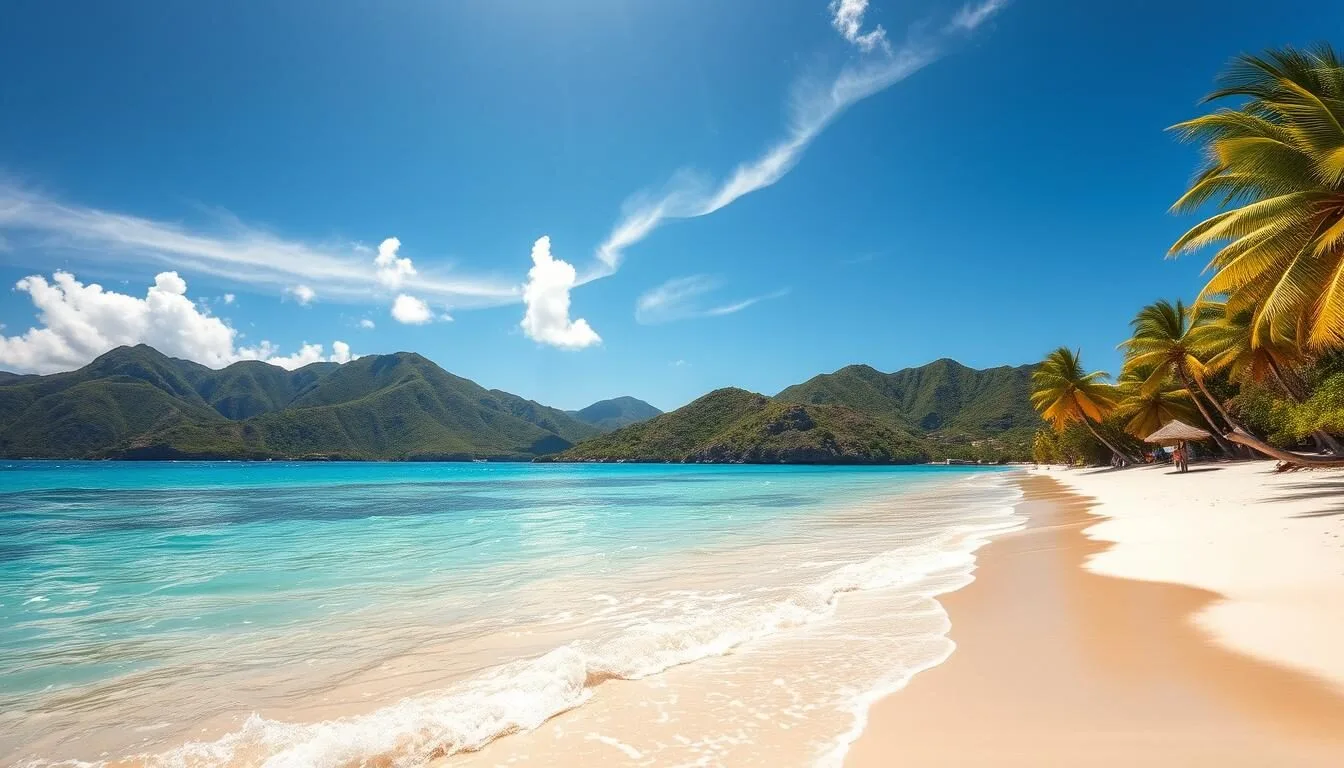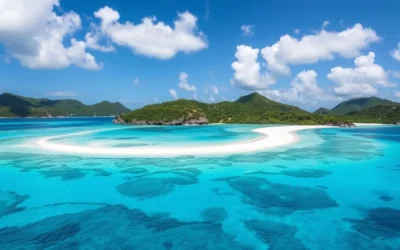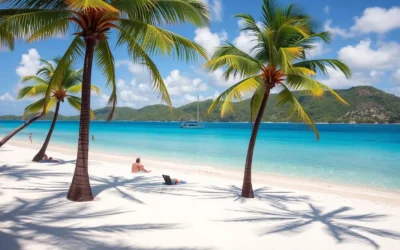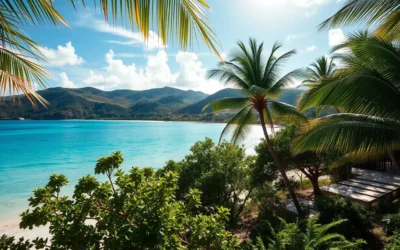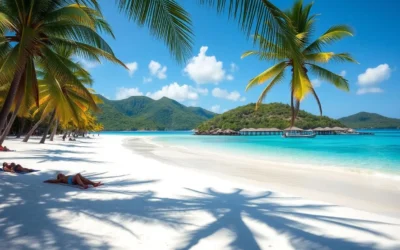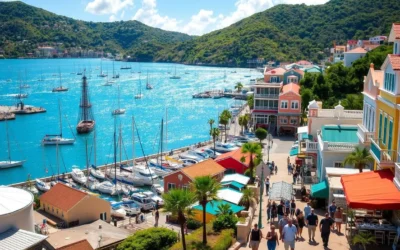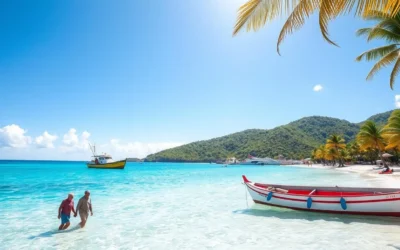Imagine yourself on a beautiful sandy beach, surrounded by crystal-clear turquoise waters perfect for swimming, snorkeling, and diving. The U.S. Virgin Islands, comprising St. Thomas, St. John, and St. Croix, offer a unique blend of natural beauty, adventure, and relaxation.
You can indulge in duty-free shopping in St. Thomas, explore pristine national park beaches in St. John, or visit rich historical sites in St. Croix. With plenty of activities to enjoy, from hiking and kayaking to exploring historical ruins and savoring exceptional dining experiences, the islands cater to all types of travelers.
Whether you’re seeking adventure, relaxation, or cultural experiences, this comprehensive guide will walk you through the top things to do across all three islands, helping you plan the perfect Caribbean getaway.
Discovering the U.S. Virgin Islands Paradise
The U.S. Virgin Islands, comprising St. Thomas, St. John, and St. Croix, are a treasure trove of natural beauty and cultural heritage. This archipelago in the Caribbean is renowned for its stunning beaches, rich history, and vibrant culture, making it a popular destination for travelers from around the world.
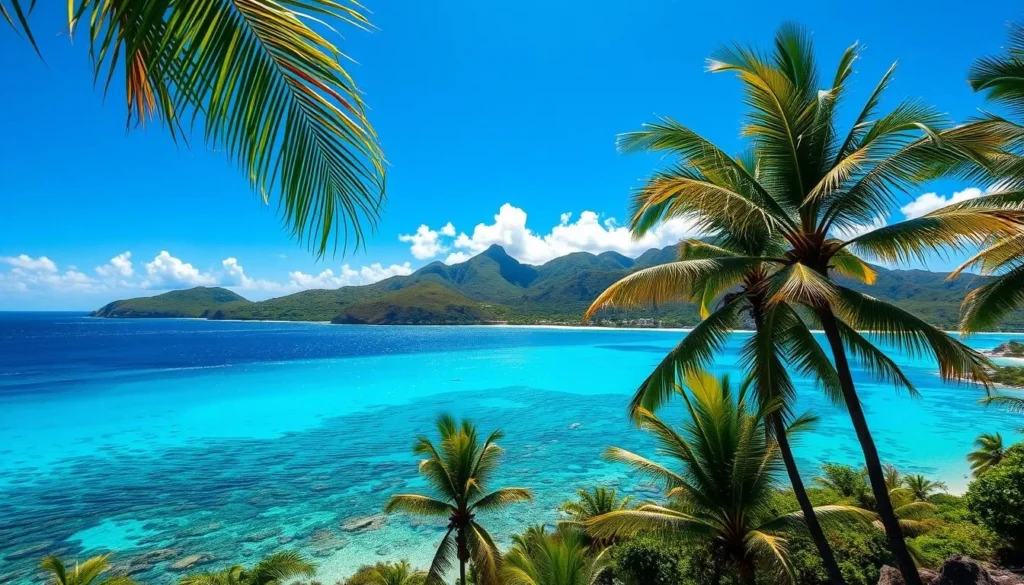
The Three Main Islands: St. Thomas, St. John, and St. Croix
The U.S. Virgin Islands are made up of three main islands, each offering distinct experiences. St. Thomas is known for its vibrant shopping and cruise port, with Charlotte Amalie being a major hub for duty-free shopping and historic sites. The island’s bustling harbor welcomes cruise ships, making it a busy and exciting destination.
St. John, on the other hand, is a nature lover’s paradise. Approximately two-thirds of the island is protected as Virgin Islands National Park, featuring pristine beaches, hiking trails, and well-preserved coral reefs. This makes St. John an ideal spot for those seeking to connect with nature and enjoy outdoor activities.
St. Croix, the largest of the three islands, offers a blend of Danish colonial history, agricultural landscapes, and a more authentic local experience. Visitors can explore the island’s historic sites, enjoy its laid-back atmosphere, and experience the local culture away from the heavier tourism of the other islands.
The Unique Cultural Tapestry of the USVI
The cultural tapestry of the U.S. Virgin Islands reflects centuries of African, European, and Caribbean influences. This unique blend is visible in the architecture, cuisine, music, and local traditions of the islands. The islands’ history is palpable in the historic sites and landmarks, while the local cuisine offers a delicious mix of flavors and dishes.
Each island hosts its own carnival celebration, showcasing the vibrant culture and festive spirit of the USVI. The Crucian Christmas Festival in St. Croix, the St. Thomas Carnival in spring, and the St. John Celebration in summer are all significant events that attract visitors and locals alike.
When to Visit the U.S. Virgin Islands
The U.S. Virgin Islands enjoy a tropical climate year-round, with temperatures consistently in the mid-70s to mid-80s. However, the best time to visit depends on your preferences regarding weather and crowds. The high season, from December to April, is characterized by pleasant trade winds, making it ideal for sailing and other outdoor activities.
The summer and fall months, from June to November, constitute hurricane season, with fewer crowds but potential weather disruptions. For travelers on a tight budget, this “off-season” can offer more value and fewer crowds, making it a good time to visit if you are looking for a more relaxed experience.
Getting to and Around the U.S. Virgin Islands
Getting to the U.S. Virgin Islands is relatively straightforward, with frequent direct flights from major cities in the United States. Whether you’re traveling from Atlanta, New York, or Miami, you have multiple options to reach this Caribbean paradise.
Flight Options and Ferry Services
The U.S. Virgin Islands are served by airports on St. Thomas and St. Croix, making it easy to fly in from major U.S. cities. You can also connect through San Juan, Puerto Rico, and take a short commuter flight to the USVI. Once you’ve arrived, inter-island travel is possible via ferry services that connect St. Thomas to St. John and less frequently to St. Croix or the British Virgin Islands.
Flight and Ferry Options:
| Travel Method | Route | Frequency |
|---|---|---|
| Direct Flights | Major U.S. cities to St. Thomas and St. Croix | Frequent |
| Commuter Flights | San Juan, Puerto Rico to USVI | Available |
| Ferry Services | St. Thomas to St. John | Frequent |
| Ferry Services | St. Thomas/St. John to St. Croix or British Virgin Islands | Less Frequent |
Transportation on the Islands
Once you arrive in the U.S. Virgin Islands, you’ll find several transportation options. Taxis are plentiful, especially for cruise passengers, and offer a convenient way to get around for the day. However, they operate on a per-person fee system, which can become expensive for families or groups. The local public transit system, VITRAN, is the most economical option but has limited routes and unreliable schedules.
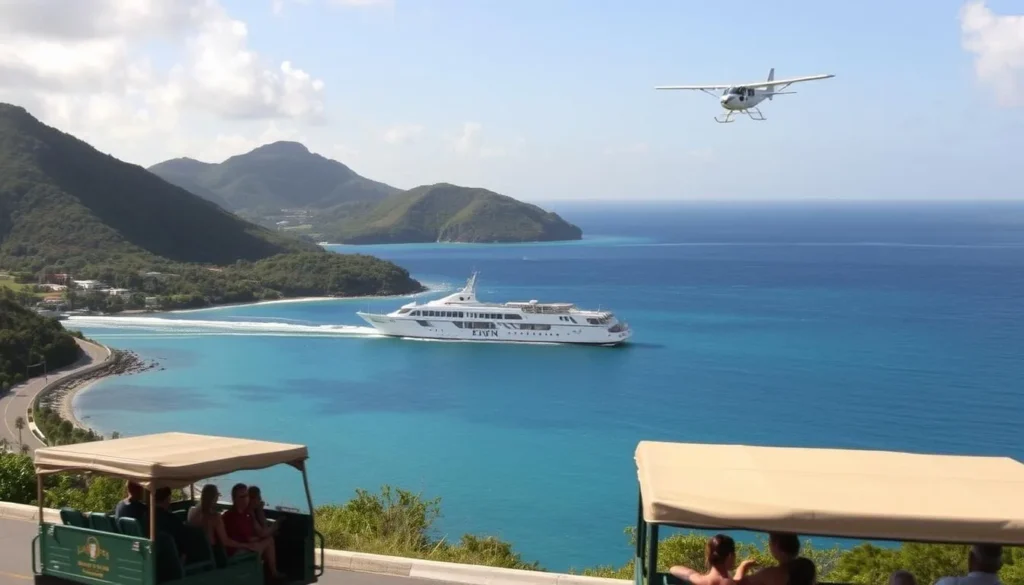
For visitors staying several days, renting a car provides the most flexibility. You’ll need to adjust to driving on the left side of the road while using American cars with steering wheels on the left.
Driving Tips for Visitors
Roads on St. Thomas and St. John are particularly winding and steep, with speed limits rarely exceeding 30mph. St. Croix has some longer, straighter stretches. When driving, be prepared for narrow roads, occasional wildlife crossings, and the need to park completely off the road without damaging vegetation when stopping at beaches or trailheads.
Driving Tips:
- Drive on the left side of the road.
- Be cautious of narrow and winding roads.
- Watch out for wildlife crossings.
- Park off the road to avoid damaging vegetation.
St. Thomas: Shopping and Scenic Beauty
St. Thomas, a gem in the U.S. Virgin Islands, is renowned for its exceptional shopping experiences and breathtaking scenic beauty. As you explore this island, you’ll discover a perfect blend of retail therapy and natural wonders.
Duty-Free Shopping in Charlotte Amalie
St. Thomas is widely known as one of the best shopping destinations in the Caribbean. If you’re looking for diamonds, luxury watches, or other jewelry, prices are below stateside costs with no sales tax. The duty-free allowance is $1,600 per person, including children, making it an ideal place for shopping.
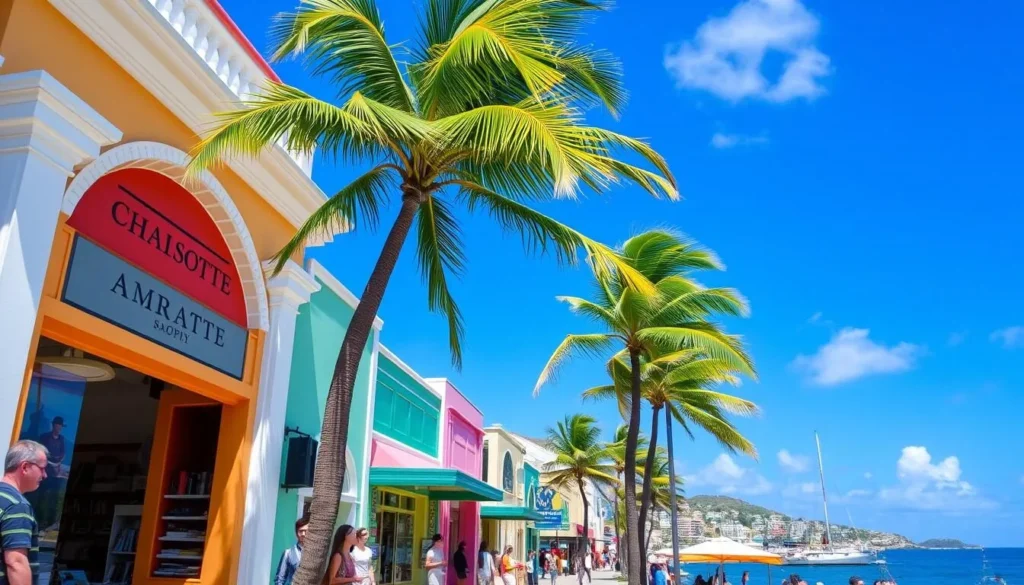
You’ll find numerous shopping opportunities in downtown Charlotte Amalie, Havensight Mall, Red Hook, Crown Bay Center, and the upscale Yacht Haven Grande. The capital city, Charlotte Amalie, features charming historic buildings housing countless shops and boutiques where you can take advantage of the generous duty-free allowance.
Magens Bay: The World-Famous Beach
Magens Bay is consistently rated among the world’s most beautiful beaches, offering a stunning mile-long stretch of white sand with calm, crystal-clear turquoise waters perfect for swimming and water activities. The beach provides excellent amenities, including watersports rentals, a beach bar, and food concessions, making it ideal for spending a full day enjoying both relaxation and activities.
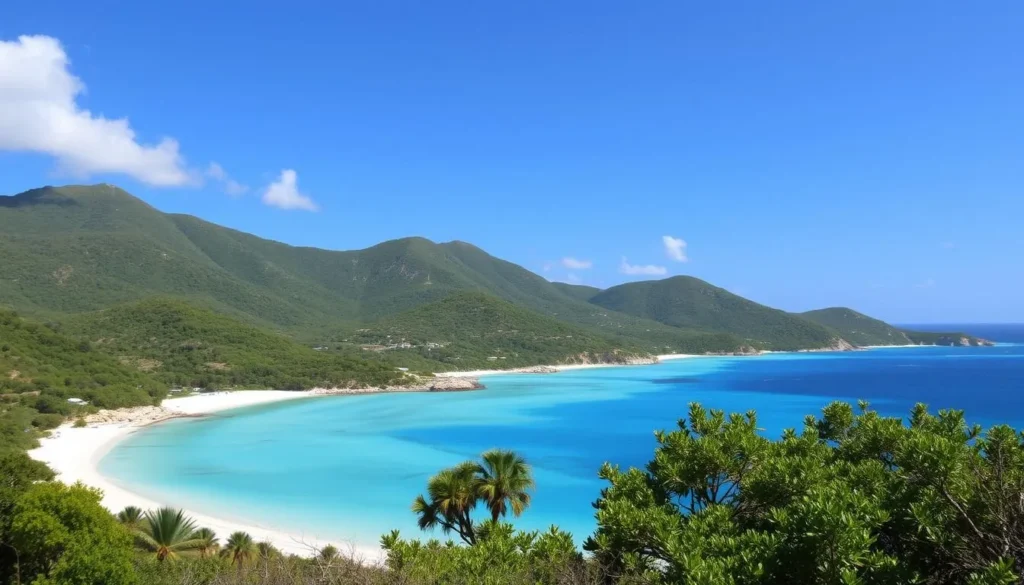
Besides swimming and sunbathing, you can enjoy hiking the nature trail, kayaking, paddleboarding, and snorkeling. Magens Bay is truly a paradise for beach lovers, offering a serene and picturesque environment.
Drake’s Seat Viewpoint
For a spectacular panoramic view, Drake’s Seat viewpoint offers breathtaking vistas of Magens Bay and the surrounding islands. Named after the British privateer Sir Francis Drake, who allegedly used this spot to watch for enemy ships, it’s a must-visit location. Visit Drake’s Seat in the late afternoon for the most enchanting light conditions, though be prepared for crowds as it’s a popular stop on island tours.
Image of Drake’s Seat viewpoint
While St. Thomas is known for its commercial aspects, the island’s natural beauty rivals that of its neighbors, with lush mountains, scenic overlooks, and beautiful beaches providing a perfect balance to the shopping experience. Whether you’re shopping, sightseeing, or relaxing on the beach, St. Thomas has something for everyone.
Coral World Ocean Park: Underwater Adventures

Discover the underwater world of the U.S. Virgin Islands at Coral World Ocean Park, where adventure and education come together. Located adjacent to Coki Beach on St. Thomas, Coral World Ocean Park is one of the island’s most popular attractions, offering a unique opportunity to explore and learn about Caribbean marine ecosystems.
Undersea Observatory and Marine Exhibits
The park’s Undersea Observatory is a highlight, allowing you to descend 15 feet below the surface in a dry environment. Here, you can observe the coral reef and its inhabitants through large windows, providing a panoramic view of the underwater world without getting wet. The marine exhibits showcase a diverse array of Caribbean sea life, including colorful reef fish, sea turtles, and sharks.
Sea Trek Helmet Diving Experience
For a more immersive experience, the Sea Trek helmet diving program lets you walk along an underwater trail on the ocean floor while breathing normally through a specially designed helmet. This accessible underwater walking tour brings you face-to-face with tropical fish, coral formations, and other marine life in their natural habitat. No diving certification or swimming skills are required, making it an ideal experience for families and beginners.
Stingray and Dolphin Encounters
Coral World Ocean Park also features interactive animal encounters, including opportunities to touch and feed stingrays in a controlled environment. You can observe bottlenose dolphins and South American sea lions during educational presentations, learning about their behavior, habitat, and conservation status. These encounters provide a unique and memorable experience, promoting a deeper appreciation for marine life.
Throughout your visit to Coral World Ocean Park, you’ll have the chance to learn about the importance of marine conservation and the challenges facing coral reefs and marine environments. The park’s educational programs highlight the actions you can take to help protect these fragile ecosystems, enhancing your appreciation for the natural world.
St. John: Natural Beauty and National Park Treasures
With its pristine beaches, coral reefs, and lush tropical forests, St. John is a paradise for nature lovers and adventure seekers. The island is home to the Virgin Islands National Park, which protects and preserves some of the world’s most beautiful beaches, colorful reefs, and historic ruins.
Virgin Islands National Park Overview
The Virgin Islands National Park was established in 1956 through a generous donation from Laurance Rockefeller. It encompasses over 7,000 acres of land and 5,650 acres of adjacent underwater habitat, creating a paradise for nature lovers and adventure seekers alike. The park protects pristine beaches, coral reefs, historic ruins, and diverse tropical forests that cover the hills of this U.S. Virgin Island.
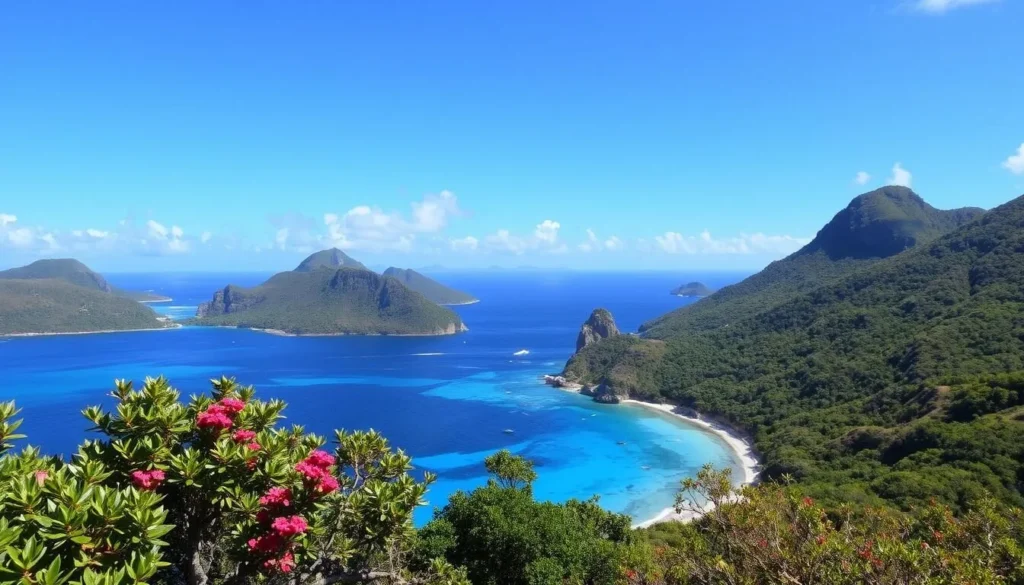
Cruz Bay: Gateway to Paradise
Cruz Bay serves as the main town and gateway to St. John, where ferries from St. Thomas arrive. Visitors can find the National Park Visitor Center, restaurants, shops, and transportation options to explore the island. Cruz Bay is the perfect starting point for your adventure on St. John, offering a range of amenities and services to suit your needs.
Best Time to Visit St. John
The best time to visit St. John is during the winter months (December to April) when temperatures are milder and rainfall is minimal. This period coincides with the high tourist season and higher prices. Spring (May-June) offers a sweet spot with fewer crowds and good weather before hurricane season, while summer and fall (July-November) bring lower prices and less crowded beaches but higher temperatures and potential storm risks.
The island experiences consistent tropical temperatures year-round, typically ranging from the mid-70s to mid-80s Fahrenheit, with the water temperature remaining pleasantly warm throughout the year. Whether you’re looking for a relaxing getaway or an action-packed adventure, St. John has something to offer.
Top Beaches on St. John
St. John’s beaches are the crown jewels of the Virgin Islands National Park, boasting some of the most beautiful and pristine shores in the Caribbean. The island is home to a diverse range of beaches, each with its unique character and attractions.
Trunk Bay: Picture-Perfect Paradise
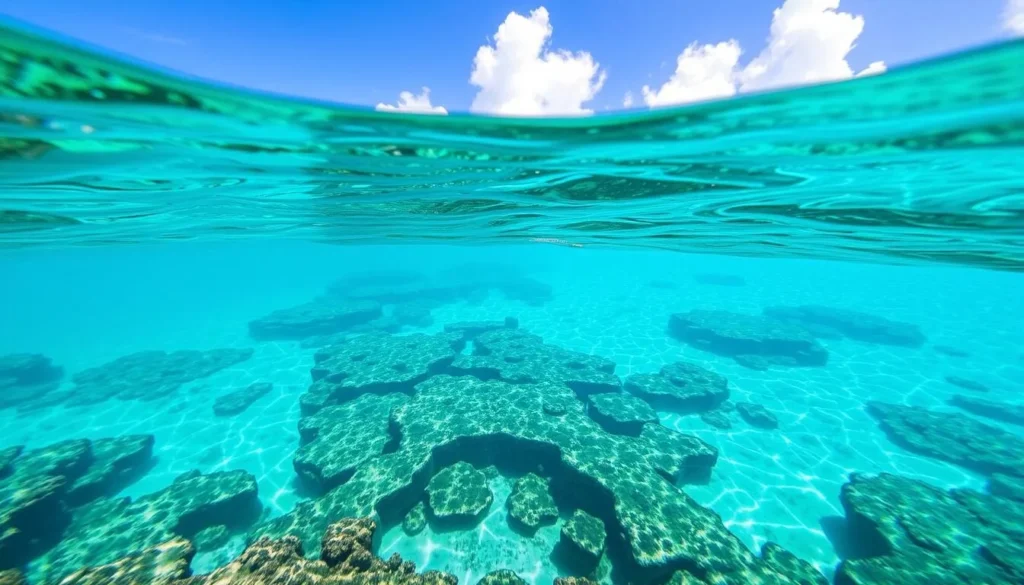
Trunk Bay is one of the most iconic beaches on St. John, renowned for its picture-perfect crescent of powdery white sand and extraordinarily clear turquoise waters. The bay features a famous underwater snorkel trail with underwater markers identifying coral formations and marine life, making it an ideal spot for beginner snorkelers. Trunk Bay also offers a range of amenities, including lifeguards, snorkel rentals, showers, and a snack bar.
Cinnamon Bay: Camping and Recreation
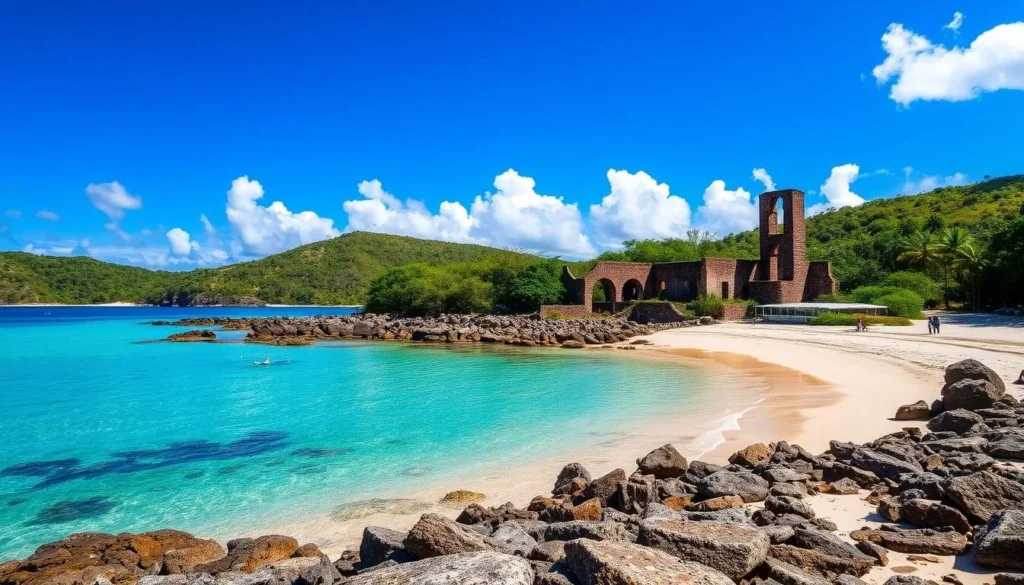
Cinnamon Bay is the longest beach on St. John, offering a wide stretch of sand that rarely feels crowded. The bay is home to the only campground within the Virgin Islands National Park, allowing visitors to experience the beach at sunrise and sunset when day-trippers are gone. The Cinnamon Bay area also includes hiking trails, historic sugar mill ruins, and excellent facilities, including a watersports rental center where you can rent kayaks, paddleboards, and snorkel gear to explore the bay’s underwater world.
Maho Bay: Wildlife and Calm Waters
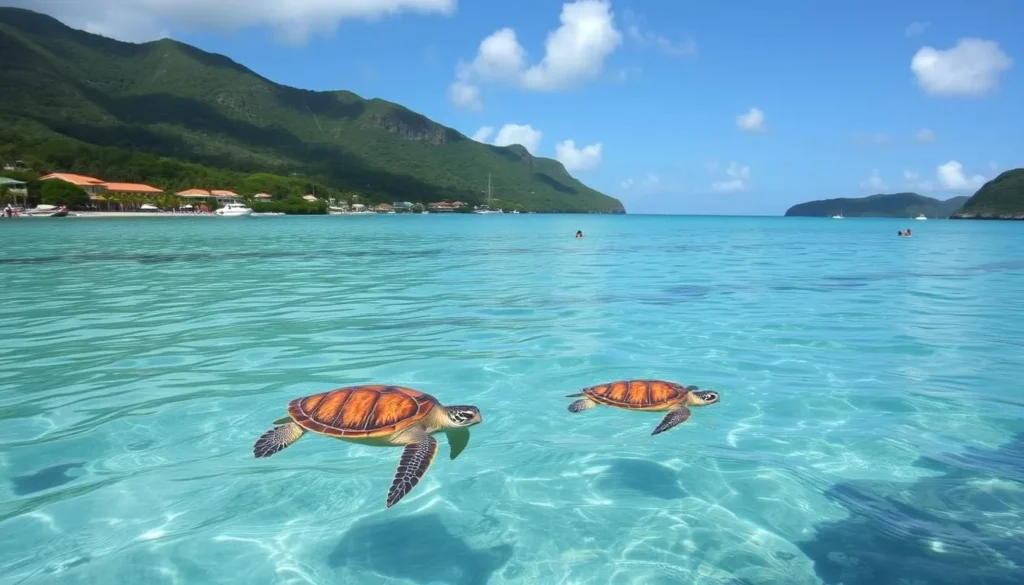
Maho Bay has become famous for its resident sea turtles and rays that can often be spotted swimming in the shallow, calm waters just a few feet from shore. The beach features a backdrop of coconut palms and sea grape trees providing natural shade, with calm protected waters that make it ideal for families with children or those seeking gentle swimming conditions.
Hawksnest Bay: Accessible Snorkeling
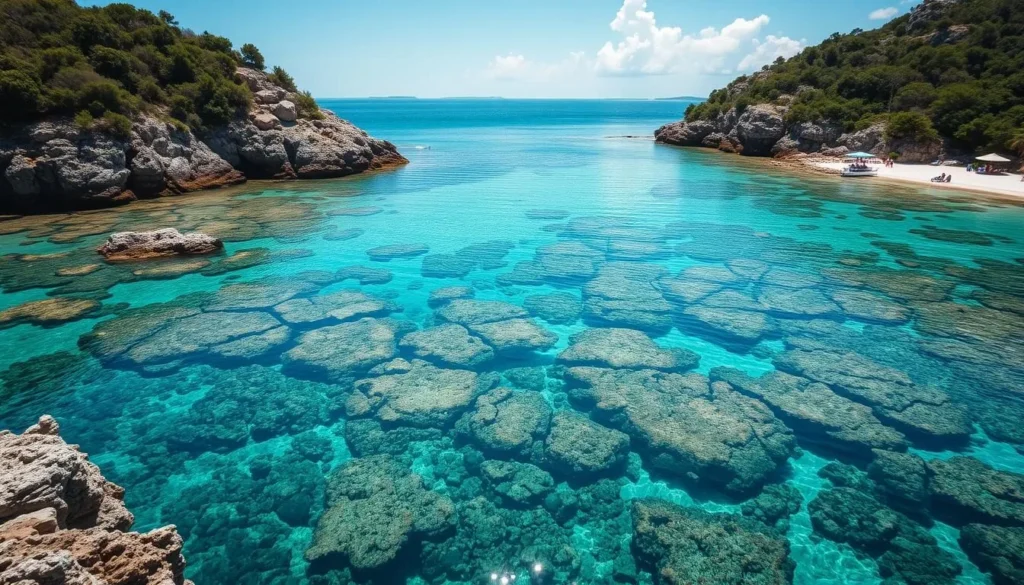
Hawksnest Bay is a small but beautiful beach along North Shore Road, just 2 miles from the Visitor Center in Cruz Bay. The bay offers excellent accessible snorkeling with three small coral reefs located just offshore, allowing snorkelers to easily swim from the beach to explore vibrant marine life in shallow water. A narrow white sand beach stretches along the shoreline, with a few opportunities to set up under some shade along the tree line.
Hidden Gems of St. John
Beyond the popular tourist spots, St. John in the U.S. Virgin Islands hides some of its most beautiful secrets. While many visitors flock to the well-known beaches, the island’s lesser-known treasures remain a secret. For those willing to venture beyond the usual tourist destinations, St. John reveals its most stunning and serene landscapes.
Denis Bay: Secluded Beach Paradise
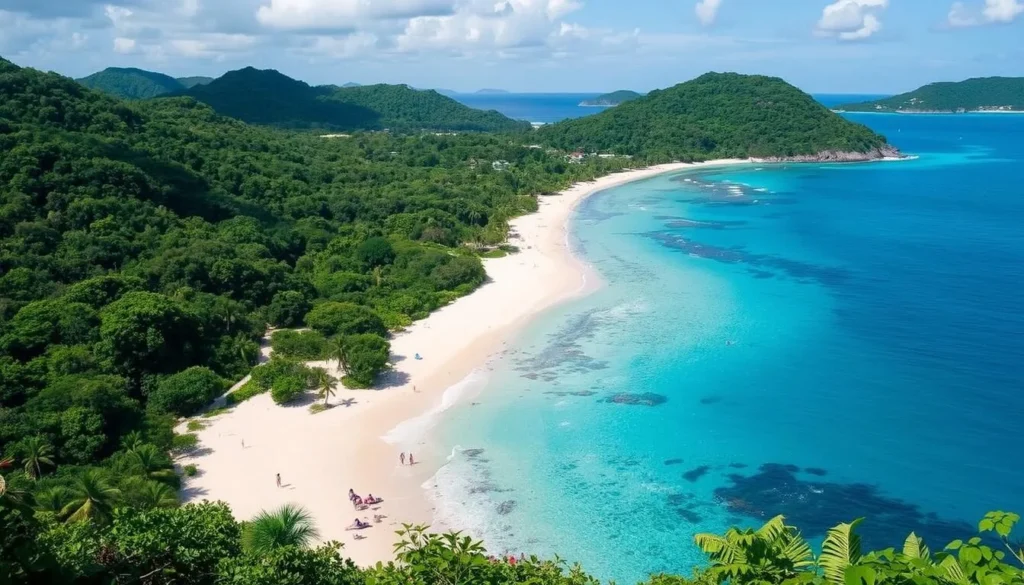
Denis Bay is one of St. John’s best-kept secrets, accessible via an unmarked trail that branches off from the Peace Hill path. The 10-minute downhill hike through a shaded forest keeps many casual tourists away, making it an ideal spot for those seeking seclusion. The effort to reach Denis Bay is richly rewarded with a stunning beach featuring crystal-clear blue waters against a dramatic mountainous backdrop.
The beach is often nearly deserted, allowing visitors to enjoy the picturesque paradise almost entirely to themselves. Denis Bay is also home to one of the few remaining “leaning palms” that survived Hurricane Irma, creating a quintessential Caribbean postcard image.
Peace Hill Ruins and Viewpoint
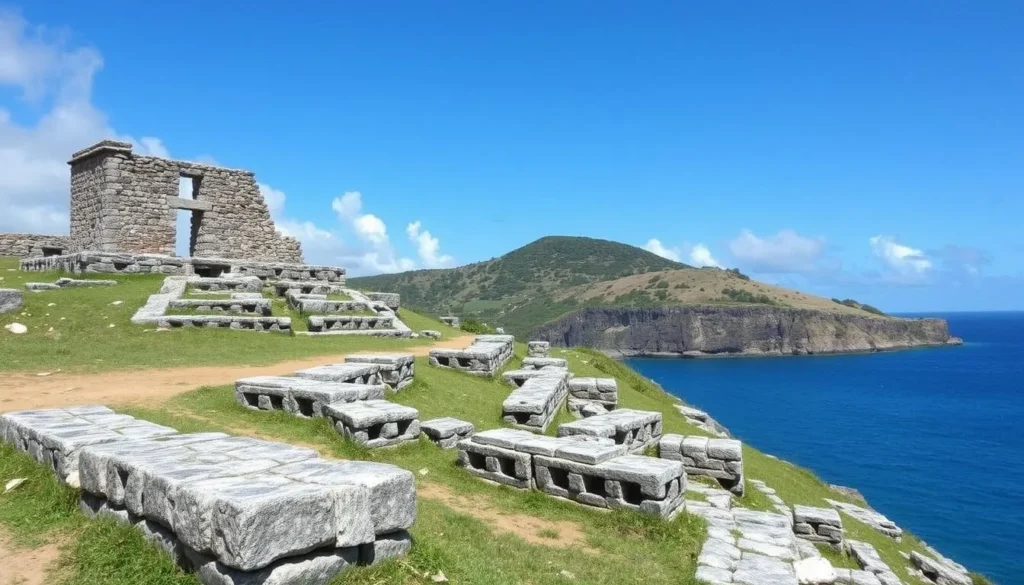
Peace Hill Ruins offers both historical interest and spectacular views, featuring a 300-year-old sugar mill windmill tower that visitors can explore. The short but steep hike to Peace Hill takes just a few minutes from the parking area on North Shore Road, making it an accessible viewpoint. From the clearing at the top, panoramic vistas of both Hawksnest Bay and Trunk Bay can be enjoyed.
The historical significance of Peace Hill Ruins adds depth to the visit, as visitors can learn about the island’s history while taking in the breathtaking views. This spot is surprisingly overlooked by many visitors, making it a hidden gem worth exploring.
Jumbie Beach: Off the Beaten Path
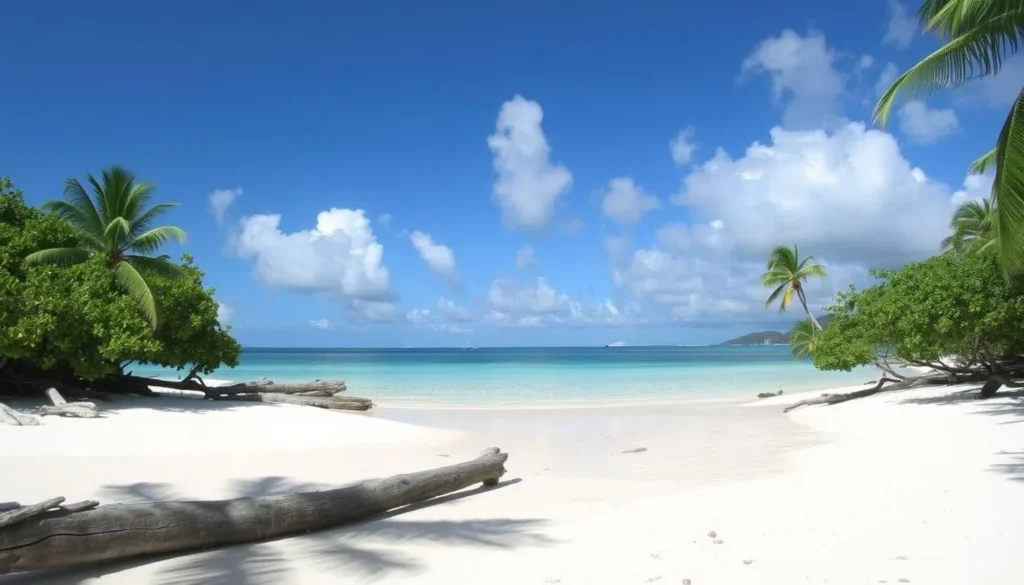
Jumbie Beach, a tiny pocket of sand accessible via a short but steep path from North Shore Road, offers intimacy and seclusion rarely found at the more popular beaches. The beach is perfect for those seeking a tranquil atmosphere, with excellent snorkeling just offshore. The seclusion of Jumbie Beach makes it an ideal destination for visitors looking to escape the crowds.
The short hike to Jumbie Beach is worth the effort, as it rewards visitors with a serene and picturesque beach experience. With its clear waters and sandy shore, Jumbie Beach is a true hidden gem of St. John.
U.S. Virgin Islands: Best Things to Do – Top Picks for Hikers
Explore the natural beauty and rich history of the U.S. Virgin Islands through its exceptional hiking trails. Virgin Islands National Park offers a variety of hiking experiences that cater to different interests and fitness levels, making it a paradise for hikers seeking more than just beach activities.
Reef Bay Trail: History and Nature
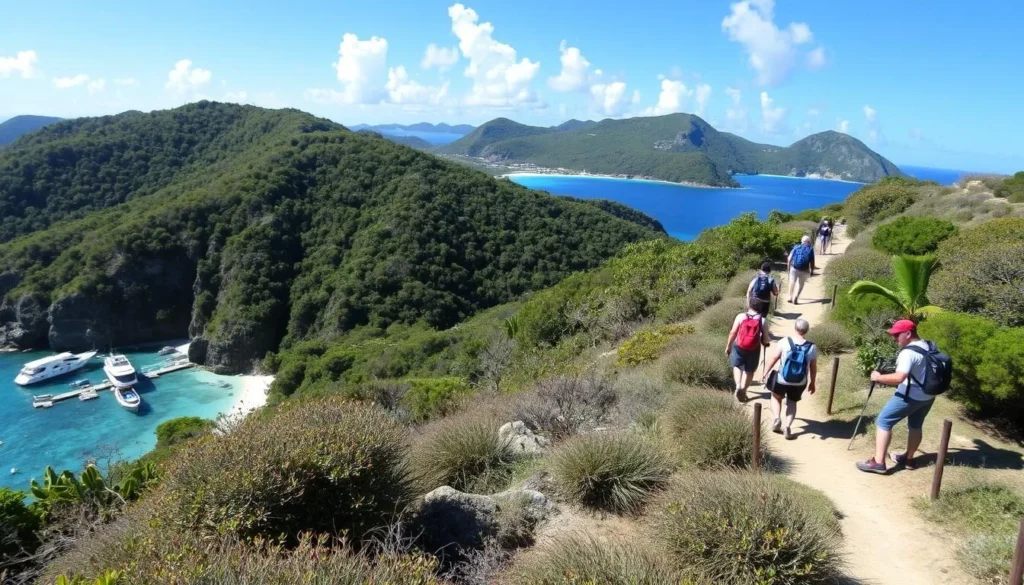
The Reef Bay Trail is a signature hike within the Virgin Islands National Park, descending 937 feet from the island’s central ridge down to the south shore through a lush tropical forest. This 4.4-mile round-trip hike (or 2.2 miles one-way with the NPS boat shuttle) passes by Danish sugar plantation ruins, a freshwater spring, and rare pre-Columbian petroglyphs carved by the Taino people. The trail culminates at a secluded beach, perfect for a refreshing swim.
Ram Head Trail: Dramatic Coastal Views
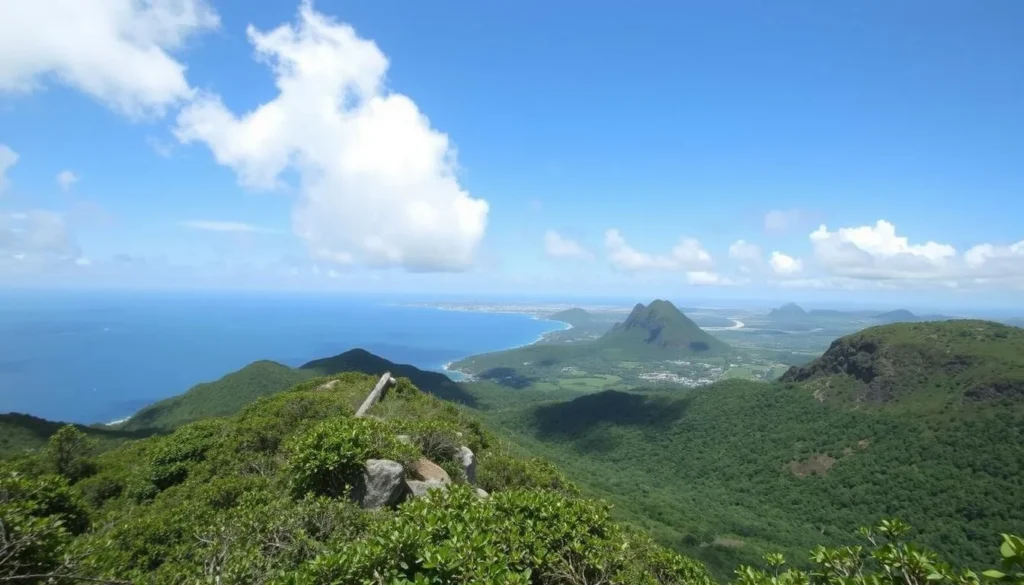
Located on the southeastern tip of St. John, the Ram Head Trail offers a dramatically different hiking experience, featuring dry, cactus-studded terrain and stunning coastal views. This 2-mile round-trip trail begins at Salt Pond Bay and traverses a narrow isthmus before ascending to a windswept promontory 200 feet above the Atlantic waves, providing some of the most spectacular photo opportunities in the Virgin Islands National Park.
Leinster Bay Trail to Waterlemon Cay
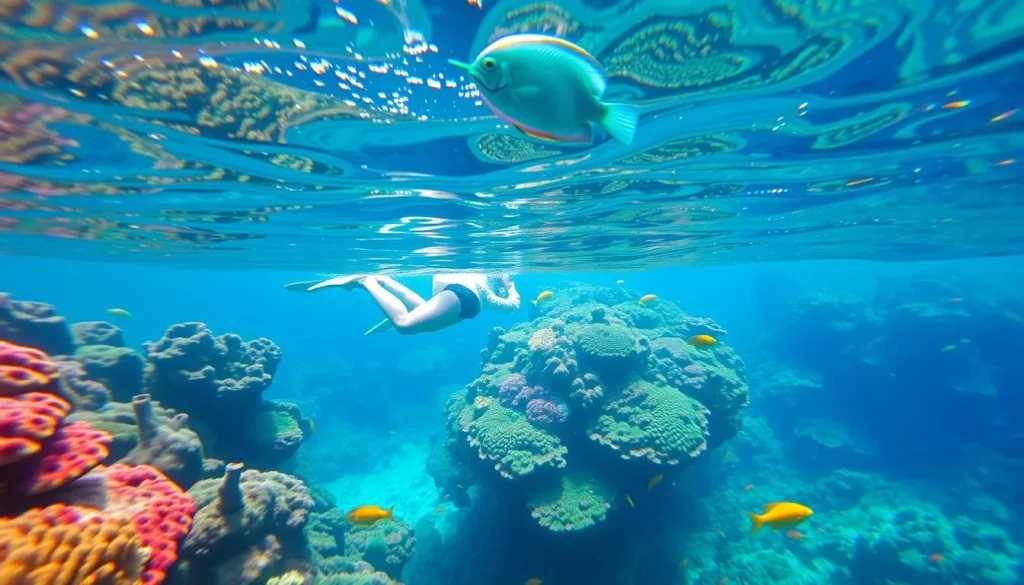
The Leinster Bay Trail provides a relatively flat and easy 1-mile walk along a historic Danish road to Waterlemon Bay, where visitors can access some of the best snorkeling in the park at Waterlemon Cay. The trail follows the shoreline, offering constant beautiful views and opportunities to spot wildlife both on land and in the clear waters alongside the path. Snorkelers can swim to the cay to explore its surrounding reef, making it a perfect complement to a day of hiking and beach activities.
These hiking trails in the U.S. Virgin Islands, particularly within Virgin Islands National Park on St. John, offer a unique way to experience the islands’ natural beauty and rich cultural heritage. Whether you’re looking for a leisurely walk or a more challenging hike, the trails of St. John have something to offer, making the U.S. Virgin Islands a must-visit destination for outdoor enthusiasts.
Historical Sites and Cultural Experiences
The U.S. Virgin Islands are a treasure trove of historical sites and cultural experiences waiting to be explored. As you delve into the islands’ rich history, you’ll discover the complex past under six different flags: Spain, Great Britain, the Netherlands, France, Denmark, and the United States.
Annaberg Sugar Plantation Ruins
The Annaberg Sugar Plantation Ruins on St. John stand as the most complete and well-preserved sugar plantation in the Virgin Islands. The site features the remains of the windmill, factory, slave quarters, and great house, with interpretive signs explaining the sugar-making process and the harsh realities of plantation life for the enslaved people who worked there.
Park rangers and cultural demonstrators often provide live demonstrations of traditional practices like bread baking in the old stone ovens, basket weaving, and herbal medicine preparation, connecting visitors to the cultural heritage that survived from this difficult period.
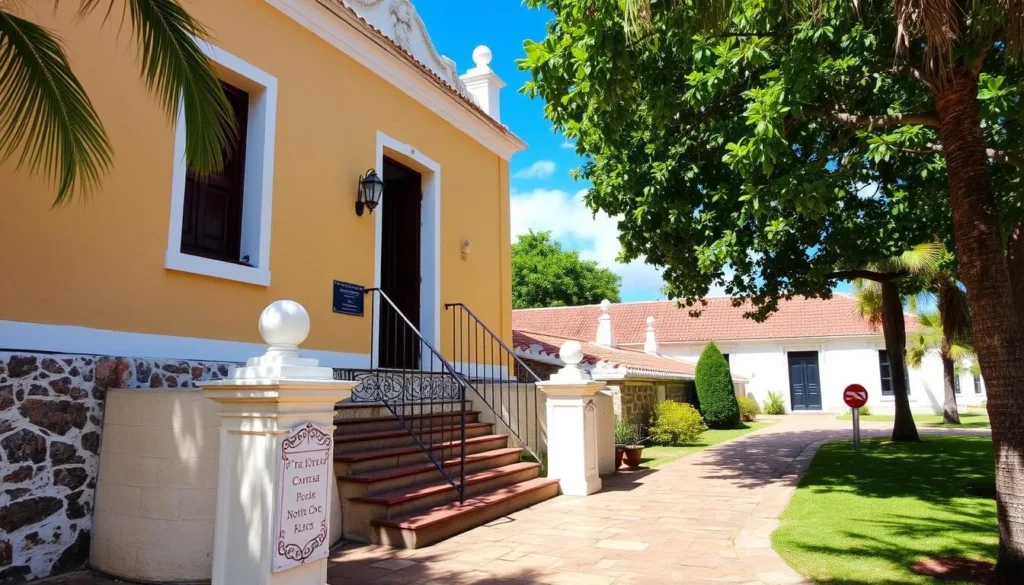
Christiansted National Historic Site
On St. Croix, the Christiansted National Historic Site preserves the urban center of what was once the capital of the Danish West Indies. The site includes Fort Christiansvaern, the Customs House, Scale House, Steeple Building, and Danish West India & Guinea Company Warehouse, offering insights into colonial administration, commerce, and military history.
The distinctive yellow brick and ballast stone buildings with red roofs create a unique architectural landscape, giving visitors a glimpse into the island’s rich history.

Cultural Demonstrations and Local Festivals
Throughout the year, the islands come alive with cultural festivals that celebrate their rich heritage. From Carnival celebrations on each island to the Crucian Christmas Festival on St. Croix, and various food festivals and jump-up parties, there’s always something happening on the U.S. Virgin Islands.
These cultural events feature colorful parades with elaborate costumes, steel pan music, calypso and quelbe (the traditional folk music of the Virgin Islands), local cuisine, and traditional crafts, providing visitors with an immersive experience of Virgin Islands culture.
St. Croix: The Largest Virgin Island
Experience the authentic Caribbean charm on St. Croix, the biggest and most culturally diverse island in the U.S. Virgin Islands. With its rich history, beautiful landscapes, and vibrant culture, St. Croix is a must-visit destination for any traveler.
Frederiksted and Christiansted: Twin Cities
St. Croix is home to two historic cities, Frederiksted and Christiansted, each with its own unique character. Christiansted boasts well-preserved Danish colonial architecture, with its distinctive yellow buildings and red roofs, while Frederiksted is known for its Victorian “gingerbread” details and deep-water pier where cruise ships dock.
Christiansted’s historic district is a treasure trove of history, featuring Fort Christiansvaern, the Scale House, and the Steeple Building. These landmarks offer a glimpse into the island’s past as the capital of the Danish West Indies.
Point Udall: Easternmost Point of the United States

Point Udall, marked by the Millennium Monument, is the easternmost point of the United States and its territories. This significant landmark offers breathtaking sunrise views for early risers. Named after Stewart Udall, the U.S. Secretary of the Interior under Presidents Kennedy and Johnson, this point is not only a geographical highlight but also a tribute to a significant figure in U.S. conservation history.
Buck Island Reef National Monument
Image of Buck Island Reef National Monument
Buck Island Reef National Monument is a protected area covering 19,015 acres just north of St. Croix. It features one of the few fully intact elkhorn coral barrier reef ecosystems in the Caribbean. Visitors can enjoy snorkeling along the underwater trail, where signs identify various marine features and species, and relax on the pristine white sand beach on the western end of the island.
This national monument is a half-day trip from St. Croix, making it an ideal day trip for those looking to explore the underwater beauty of the U.S. Virgin Islands.
Best Beaches on St. Croix
The island of St. Croix offers a unique blend of easily accessible beaches and secluded getaways, catering to a wide range of preferences among beachgoers. Whether you’re looking for vibrant spots with amenities or isolated stretches of sand, St. Croix has something for everyone.
Cane Bay: Snorkeling and Diving Paradise
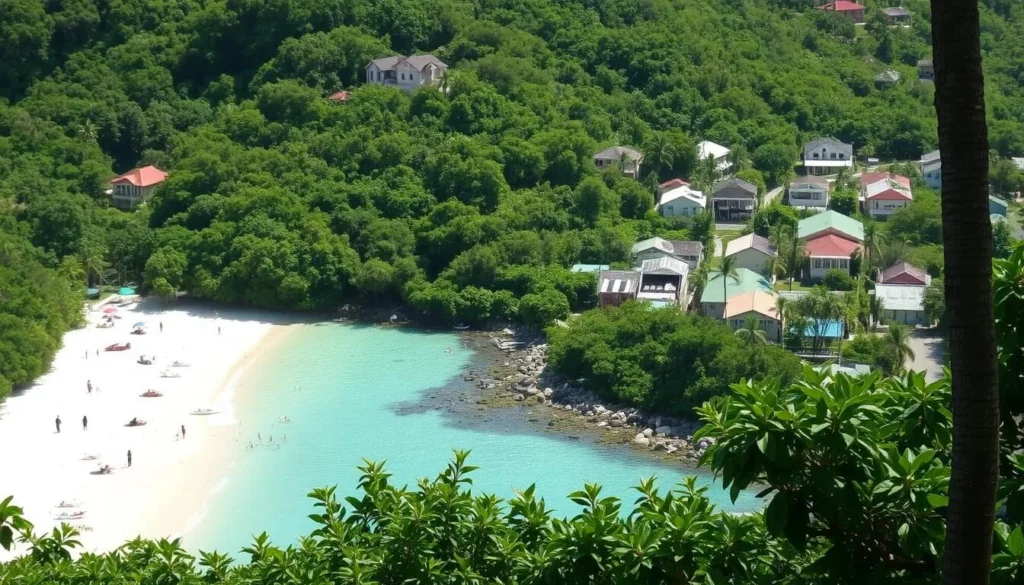
Cane Bay Beach on the north shore of St. Croix is renowned for its exceptional snorkeling and diving opportunities. The “Cane Bay Wall,” a dramatic underwater drop-off, begins just 200 yards from shore and plunges to depths of over 3,000 feet, making it a world-class destination for underwater enthusiasts.
The beach itself features a narrow strip of golden sand lined with palm trees, a relaxed beach bar and restaurant known for its happy hours, and a dive shop offering equipment rentals and guided experiences for all skill levels.
Jack Bay and Isaac Bay: Secluded Getaways
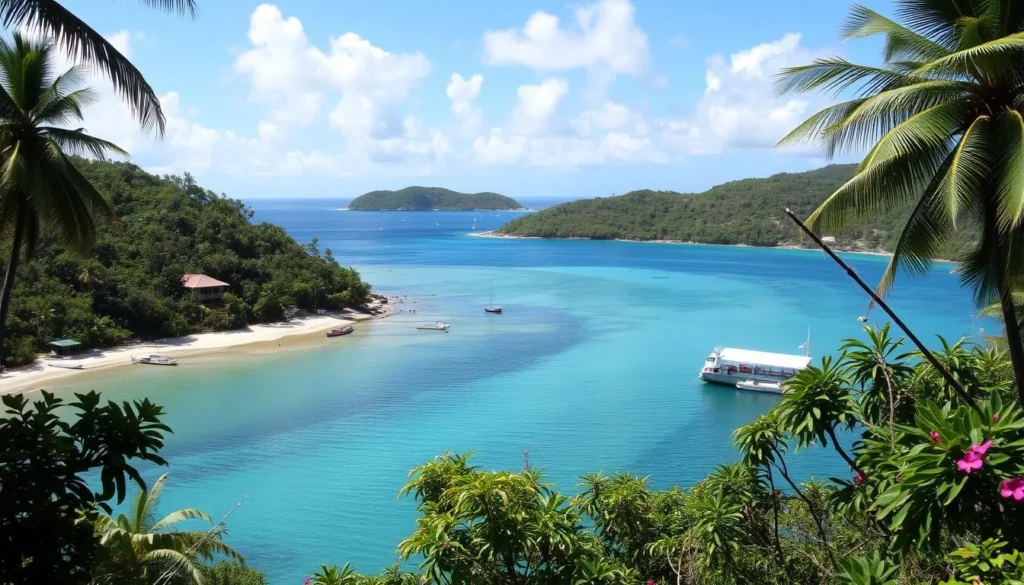
Located within the Jack and Isaac Bay Preserve on the island’s east end, these twin bays offer a true secluded beach experience for those willing to hike approximately 30 minutes down a moderately difficult trail. The effort is rewarded with nearly deserted beaches, excellent snorkeling in clear protected waters, and the possibility of spotting nesting leatherback and green sea turtles.
It’s essential to bring your own water and food, as there are no facilities in either bay. The seclusion and natural beauty of Jack Bay and Isaac Bay make them must-visit destinations for those seeking an off-the-beaten-path experience on St. Croix.
Sandy Point National Wildlife Refuge
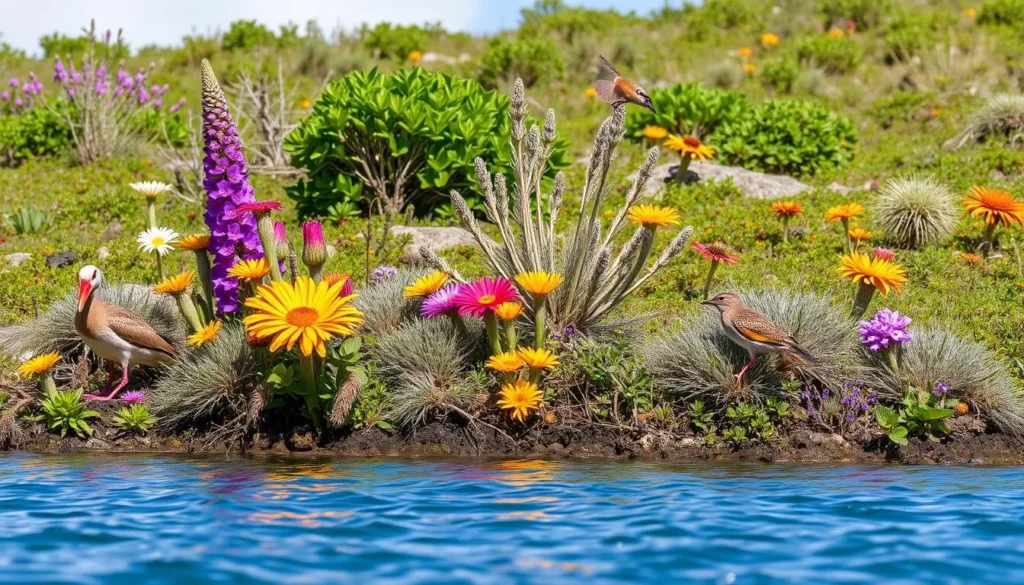
Sandy Point National Wildlife Refuge, located on the southwestern tip of St. Croix, protects the longest beach in the U.S. Virgin Islands and serves as critical nesting habitat for endangered leatherback sea turtles. The refuge is only open to the public on weekends and certain holidays from 10 am to 4 pm, and it’s closed during turtle nesting season from April through August.
Despite the access restrictions, the pristine white sand beach and crystal-clear waters of Sandy Point make it a worthwhile visit, offering a unique and protected wilderness experience on St. Croix.
Water Activities Across the Islands
Explore the underwater world and enjoy sailing adventures in the U.S. Virgin Islands. The islands offer a diverse array of water activities that cater to all interests and skill levels, making them an ideal destination for water enthusiasts.
Top Snorkeling Spots in the U.S. Virgin Islands
The U.S. Virgin Islands are renowned for their exceptional snorkeling opportunities. With visibility often exceeding 100 feet and water temperatures ranging from 79°F to 84°F year-round, the conditions are perfect for exploring the underwater world.
Trunk Bay’s underwater trail on St. John is a must-visit, offering a guided tour through a coral reef teeming with marine life. On St. Croix, Cane Bay provides an excellent snorkeling experience directly from the shore.
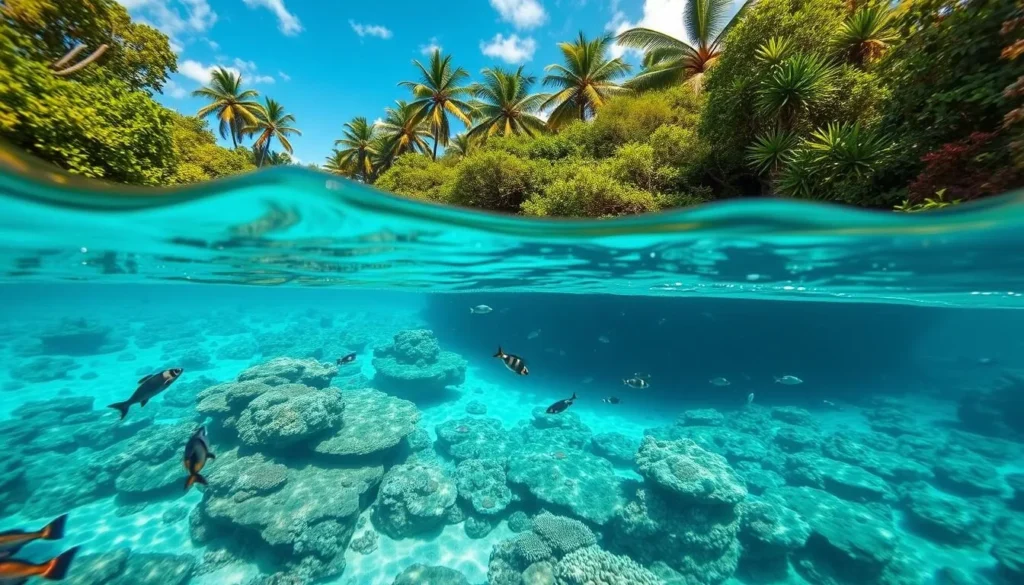
Sailing and Boat Tours
Sailing is a quintessential Virgin Islands experience. You can choose from sunset cruises, day trips, or week-long charters that allow you to island-hop and discover secluded coves and beaches accessible only by water.
The consistent trade winds, especially from November to March, create ideal sailing conditions. The close proximity of the islands means you can always find protected waters even on windier days.
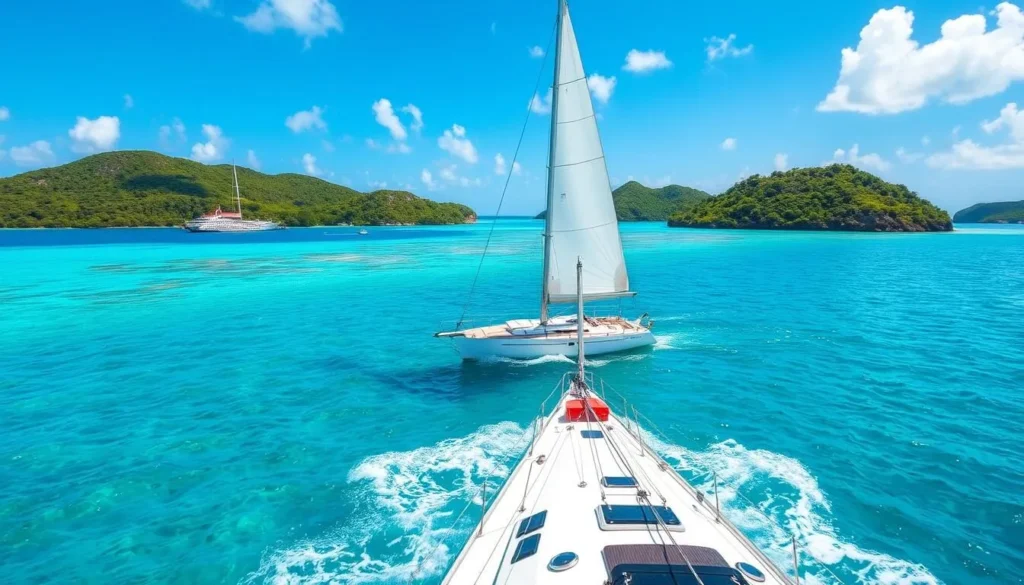
Scuba Diving Adventures
Scuba diving in the USVI offers diverse experiences for all certification levels. From shallow reef dives perfect for beginners to dramatic wall dives, canyon formations, and historic shipwrecks for advanced divers, there’s something for everyone.
The RMS Rhone, a historic shipwreck located in British Virgin Islands waters, is accessible via day trips from St. Thomas and ranks as one of the world’s top wreck dives.
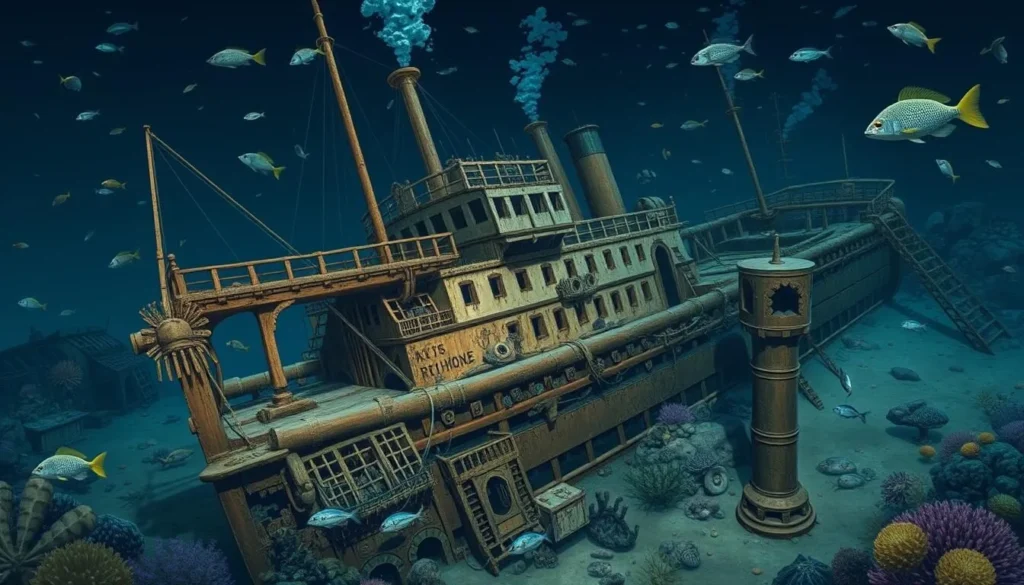
Other popular water activities in the U.S. Virgin Islands include kayaking through mangrove lagoons, stand-up paddleboarding in protected bays, jet skiing, parasailing, and fishing charters that target marlin, tuna, wahoo, and mahi-mahi depending on the season.
Culinary Experiences in the U.S. Virgin Islands
Indulge in the rich culinary heritage of the U.S. Virgin Islands, where local cuisine reflects the islands’ diverse cultural influences. The culinary scene is a vibrant blend of African, European, and Caribbean flavors, creating a unique gastronomic experience.
Local Cuisine and Specialties
The U.S. Virgin Islands’ cuisine is characterized by its use of fresh seafood, tropical fruits, and local specialties. Traditional dishes include kallaloo, a spinach-like soup made with seafood, meat, and okra; fungi, a cornmeal polenta-like side dish; pate, fried pastry filled with spiced meat or seafood; and johnnycakes, fried bread that accompanies many meals.
Fresh-caught fish and seafood are prominent on menus across the islands, with mahi-mahi, wahoo, yellowtail snapper, and Caribbean lobster prepared in various styles.
Top Restaurants on Each Island
Each island in the U.S. Virgin Islands has its own unique dining scene. On St. Thomas, you’ll find everything from casual beach bars to upscale restaurants, particularly in Charlotte Amalie, Red Hook, and Frenchtown. St. John‘s Cruz Bay is packed with quality establishments within walking distance of the ferry terminal. On St. Croix, you’ll discover farm-to-table experiences that draw on the island’s agricultural heritage.
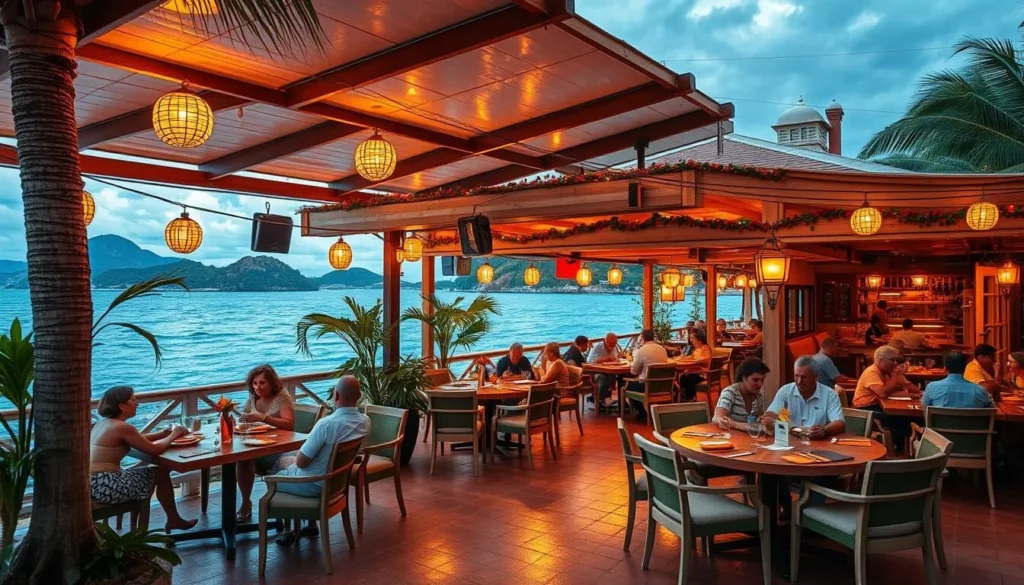
Rum Distilleries and Tastings
The U.S. Virgin Islands are famous for their rum production. The historic Cruzan Rum Distillery on St. Croix offers tours and tastings, explaining the rum-making process from sugarcane to bottle. Don’t miss trying the islands’ signature rum cocktail, the Painkiller, a delicious blend of dark rum, cream of coconut, pineapple and orange juices, topped with freshly grated nutmeg.
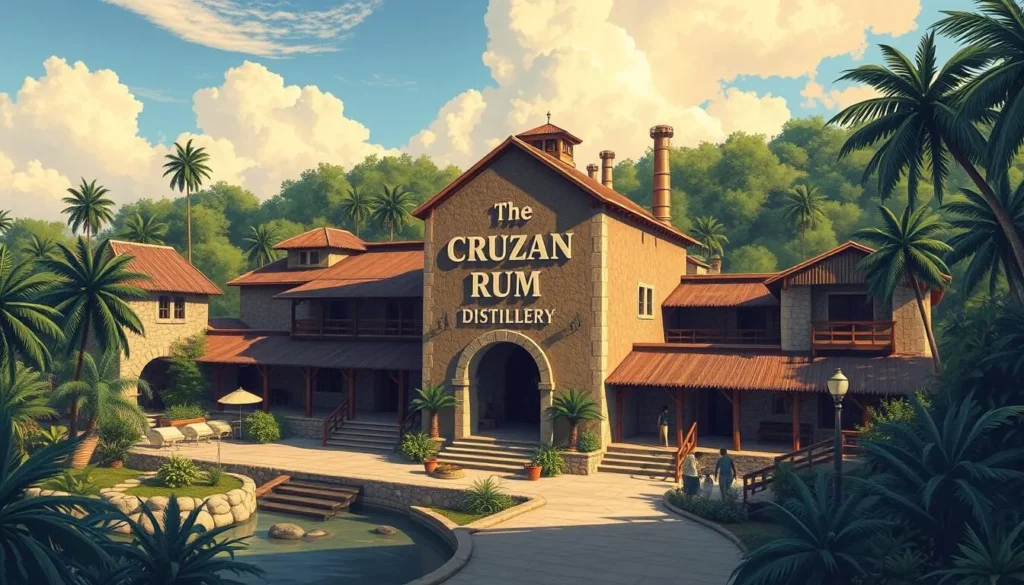
Local food trucks and roadside stands often offer some of the most authentic and affordable dining experiences, serving up barbecue, fresh seafood, and local specialties. Many restaurants incorporate local ingredients like breadfruit, cassava, soursop, and mango into their dishes, providing visitors with a true taste of the islands.
Practical Information for Visitors
To ensure a smooth and enjoyable journey, it’s essential to be prepared with the right information when visiting the U.S. Virgin Islands. The islands offer a wide range of experiences, from luxurious resorts to budget-friendly accommodations, and from fine dining to local cuisine.
Accommodation Options Across the Islands
The U.S. Virgin Islands cater to diverse travel styles and budgets, offering everything from luxury resorts and private villas to boutique hotels, vacation rentals, campgrounds, and eco-tents. On St. Thomas, you’ll find a variety of accommodations, including large resort properties with all-inclusive options. St. John is known for its smaller boutique properties and vacation rentals, while St. Croix offers a mix of historic inns, resorts, and rental properties.
For a unique experience, consider staying at Cinnamon Bay Campground on St. John, which offers tent sites, eco-tents, and cottages just steps from one of the island’s most beautiful beaches.
Budget Considerations and Money-Saving Tips
While the U.S. Virgin Islands can be expensive, visiting during the off-season (late April through November) can save you 30-50% on accommodations. Other money-saving strategies include booking accommodations with kitchens to prepare some of your own meals, taking advantage of happy hour specials at restaurants and bars, and using the public VITRAN bus system instead of taxis.
The islands use the U.S. dollar, and most places accept major credit cards. However, it’s wise to carry some cash for smaller establishments, beach vendors, and taxis, many of which are cash-only.
What to Pack for Your Virgin Islands Vacation
Packing the right items can enhance your vacation experience. Essentials include reef-safe sunscreen to protect the fragile coral ecosystems, insect repellent, a hat, sunglasses, quick-dry clothing, hiking shoes for trails, water shoes for rocky beaches, and a reusable water bottle.
Don’t forget to bring proper attire beyond just swimwear. Locals consider it disrespectful to wear bathing suits away from the beach, so pack casual but modest clothing for towns and restaurants, and something slightly dressier for upscale dining.
Day Trips and Island Hopping
With its strategic location, the U.S. Virgin Islands offer a gateway to exciting day trips and island hopping adventures. The proximity to the British Virgin Islands (BVI) makes it easy for visitors to experience the best of the Caribbean.
Visiting the British Virgin Islands
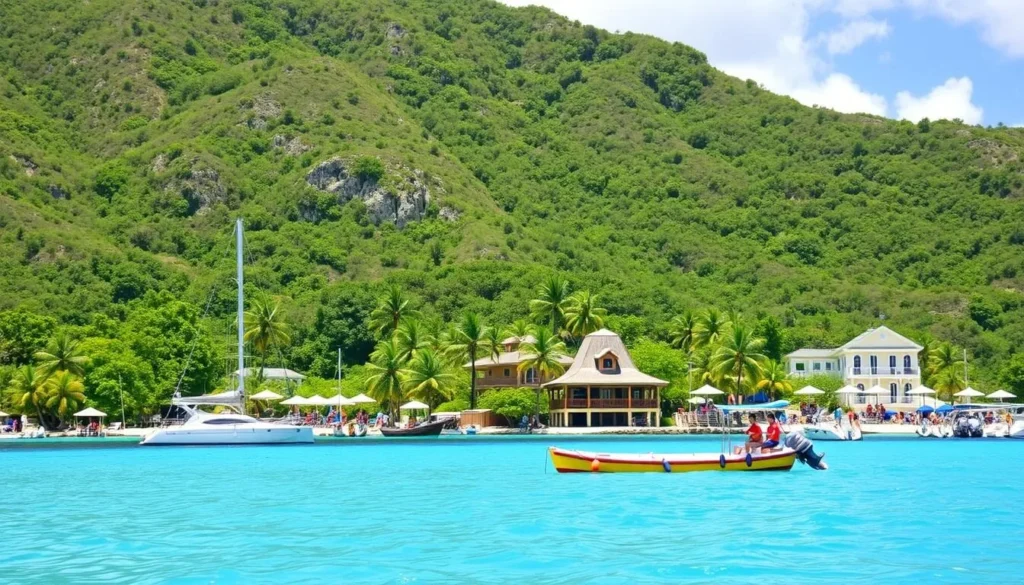
Visiting the British Virgin Islands requires a passport and going through customs and immigration. However, many tour operators offer guided day trips that handle all the logistics, making the process relatively seamless for visitors.
The most popular BVI destinations for day trips include Jost Van Dyke, known for its famous beach bars like the Soggy Dollar Bar, and Virgin Gorda, home to the spectacular rock formation known as The Baths.
Jost Van Dyke and The Baths on Virgin Gorda
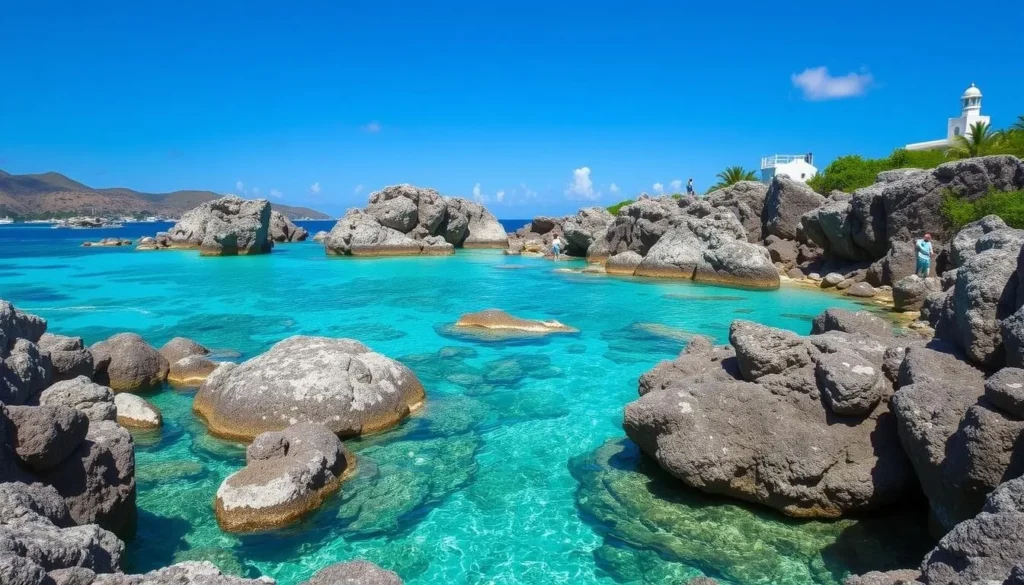
Jost Van Dyke’s White Bay offers a quintessential Caribbean beach experience with powdery white sand and clear water. The Baths National Park on Virgin Gorda features massive granite boulders forming grottos, tunnels, and tidal pools that visitors can explore.
The Baths is a must-visit spot, with its unique rock formations and beautiful beaches. It’s a great place for snorkeling and swimming.
Water Taxis and Ferry Services
Regular ferry services connect St. Thomas to Tortola, the largest BVI, with the journey taking approximately 45-60 minutes. Private water taxis and charter boats offer more flexible scheduling and the ability to visit multiple islands in one day.
Tour operators on St. Thomas and St. John offer full-day excursions that typically include transportation, customs fees, snorkeling stops, lunch, and open bar for around $150-200 per person.
For those with limited time, consider visiting Water Island, technically part of the USVI but with a distinct character, just a short ferry ride from St. Thomas.
Conclusion: Planning Your Perfect U.S. Virgin Islands Getaway
A trip to the U.S. Virgin Islands is a journey through a rich cultural heritage and breathtaking natural beauty. As you plan your dream vacation, you’ll want to consider what makes each island unique and how to make the most of your time.
The U.S. Virgin Islands offer a diverse range of experiences, from vibrant shopping districts to serene natural landscapes. You can choose to focus on one island or explore multiple islands during your stay. For instance, a week on St. Thomas and St. John allows you to experience the best of both worlds using the convenient ferry connections. Alternatively, seven days on St. Croix provides an immersive experience with ample time for relaxation and exploration.
Choosing the Right Island for You
Planning the perfect U.S. Virgin Islands vacation begins with deciding which island (or islands) best matches your travel style and interests. If you prefer shopping, nightlife, and accessibility, St. Thomas might be your top choice. For those who love natural beauty and outdoor activities, St. John is ideal. If you’re drawn to history, culture, and a more authentic Caribbean experience, St. Croix is the way to go.
Consider the length of your stay carefully. While a quick 3-4 day trip can give you a taste of one island, a week allows for a more relaxed pace and the opportunity to explore more thoroughly. With 10-14 days, you can meaningfully explore multiple islands. The ideal itinerary often combines a primary base island with day trips to others. For example, staying on St. Thomas with a day or two on St. John is a popular combination due to the quick ferry connection.
Balancing Activities and Relaxation
When planning your activities, it’s essential to strike a balance between beach time, cultural experiences, and adventures. Even dedicated beach lovers find that mixing in historical sites, hiking trails, and local cultural experiences enriches their Virgin Islands vacation. Each beach offers a different experience, from the amenities and underwater trail at Trunk Bay to the wildlife encounters at Maho Bay and the seclusion of Denis Bay. Plan to visit several beaches rather than spending all your time at just one.
To make the most of your trip, pack appropriately for a range of activities. Beyond beach gear, include hiking shoes for trails, modest clothing for towns and restaurants, and any specialty gear (like your own snorkel equipment) that you prefer not to rent.
Flexibility is Key
Building flexibility into your itinerary is crucial to account for weather changes, unexpected discoveries, and the relaxed “island time” pace that makes the Caribbean special. Some of the best experiences come from spontaneous decisions and local recommendations. Whether you’re seeking a romantic getaway, family vacation, adventure trip, or simply a peaceful retreat, the U.S. Virgin Islands offer the perfect blend of accessibility and exotic tropical beauty, with enough variety to create your ideal Caribbean experience.
In conclusion, the U.S. Virgin Islands are a versatile destination that can cater to a wide range of preferences and travel styles. By choosing the right island(s) and planning your itinerary thoughtfully, you can have a truly unforgettable vacation.
